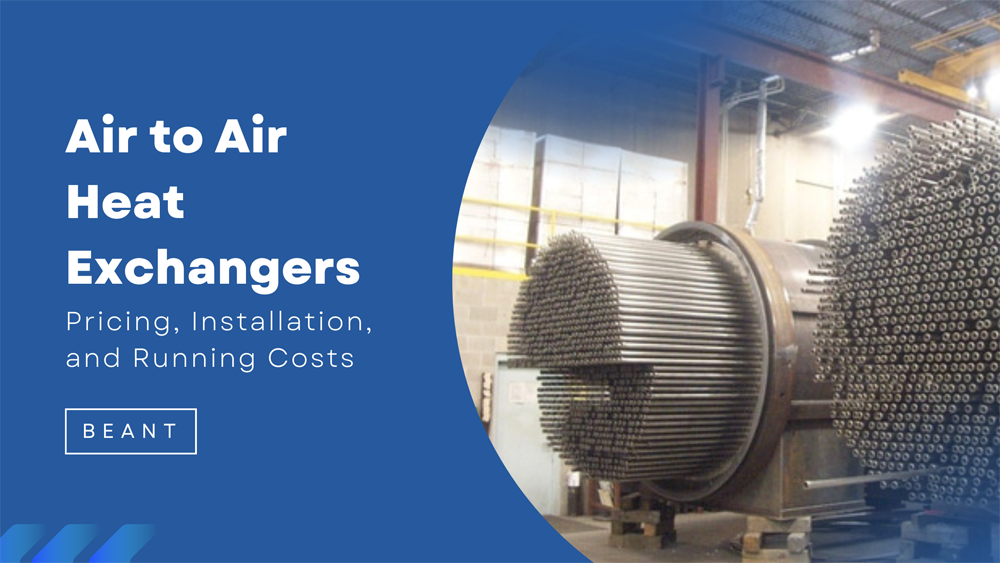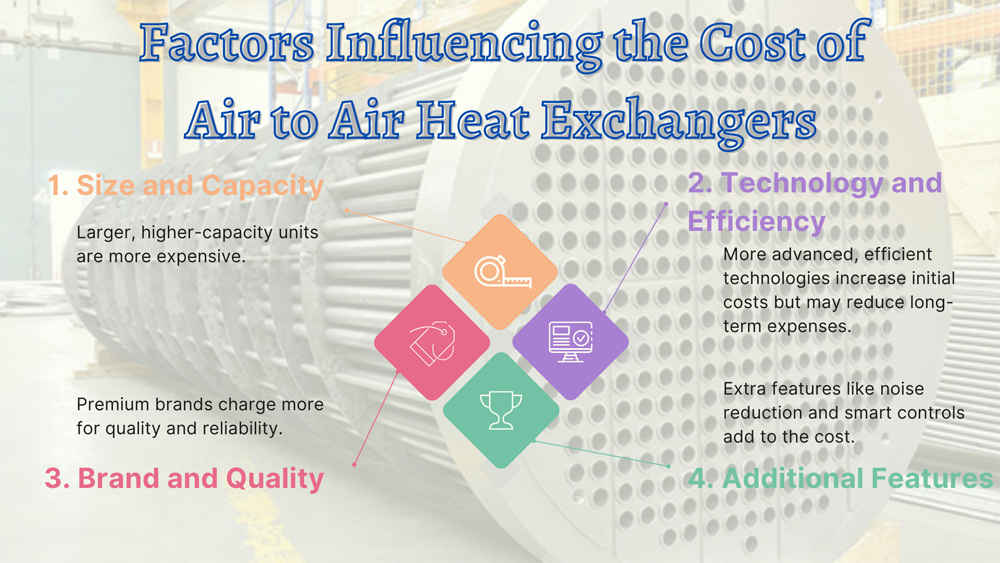
Air to air heat exchangers are efficient thermal recovery devices widely used in both industrial settings and residential buildings to optimize energy use and reduce overall heating and cooling costs. These devices work by exchanging heat between incoming and outgoing air streams, enhancing energy efficiency while maintaining indoor air quality. However, purchasing an air to air heat exchanger involves various cost considerations including the price of the equipment itself, installation fees, and the long-term expenses associated with operation and maintenance. This article delves into these cost components, helping you make an informed purchasing decision.
In the following sections, we will thoroughly explore the factors affecting the cost of air to air heat exchangers, including types of equipment, size, brand, and technological features.
When considering the purchase of an air to air heat exchanger, several key factors significantly impact the initial cost. Understanding these can help you budget more accurately and choose a system that meets your needs without overspending.
| Factor | Impact on Cost | Description |
| Size and Capacity | High | Larger, higher-capacity units are more expensive. |
| Technology | High | More advanced, efficient technologies increase initial costs but may reduce long-term expenses. |
| Brand | Moderate to High | Premium brands charge more for quality and reliability. |
| Additional Features | Variable | Extra features like noise reduction and smart controls add to the cost. |
The size and capacity of the heat exchanger are among the most critical factors affecting the price. Larger spaces require units with higher capacities, which can handle more significant volumes of air and thus are typically more expensive. The size is usually proportional to the price; the larger the unit, the higher the cost.
Advancements in technology have led to more efficient heat exchanger designs that can significantly reduce long-term operational costs. However, these technologically advanced models often come with a higher upfront price tag. High-efficiency models may incorporate features like variable speed fans and smart controls that add to the cost but offer savings through lower energy consumption over time.
Well-known brands often charge more due to their established market presence and perceived reliability. Moreover, units manufactured with higher quality materials and better warranties can also drive up the initial purchase price. Choosing a reputable brand can mean fewer maintenance issues down the line, potentially reducing overall lifetime costs.
Features such as noise reduction capabilities, integrated control systems, and compatibility with existing HVAC systems can also influence the price. While these features provide added convenience and functionality, they require more sophisticated design and manufacturing processes, adding to the cost.

The installation of an air to air heat exchanger is a critical step that can significantly affect both the initial setup costs and the long-term efficiency of the unit. Installation costs can vary widely depending on several factors:
The complexity of the installation process can greatly influence the cost. Simple installations in accessible areas with existing ductwork are generally less expensive. Conversely, installations that require extensive modifications to the building structure or specialized ductwork can be significantly more costly.
The geographical location and the specific site of installation can also impact the price. For example, installations in regions with higher labor rates will naturally have higher overall costs. Additionally, difficult-to-access sites may require special equipment or additional labor, further increasing the expenses.
The expertise and experience of the contractor performing the installation play a crucial role in determining the cost. Certified and highly skilled professionals often charge more for their services but can provide greater efficiency and reliability, potentially reducing future maintenance costs.
Sometimes, additional equipment such as controls, sensors, or customized parts are needed to fully integrate the heat exchanger into the existing HVAC system. These additions can increase the overall cost of installation.
Efficient operation and regular maintenance are crucial for maximizing the lifespan and performance of air to air heat exchangers. These costs, although recurrent, can be managed through proper understanding and planning.
Air to air heat exchangers significantly reduce the energy consumption of heating and cooling systems by recycling the heat from exhaust air. The efficiency of a unit directly affects its operational costs — more efficient units typically offer lower long-term energy expenses but may have a higher upfront cost.
Routine maintenance is essential to keep the heat exchanger operating at peak efficiency. This includes cleaning the filters, checking the ducts for leaks, and ensuring that all components are functioning correctly. The frequency and cost of maintenance depend on the model and the environment in which it operates.
Over time, parts of the heat exchanger may require repairs or replacements. The cost for repairs can vary depending on the extent of damage and the price of the parts. Investing in a unit with readily available spare parts can help reduce these costs.
The availability and cost of replacement parts are influenced by the brand and model of the heat exchanger. Units that are common and widely used tend to have more readily available parts, which can reduce the cost and downtime during repairs.
| Factor | Impact on Cost | Description |
| Energy Efficiency | High | More efficient units cost more upfront but reduce long-term energy costs. |
| Regular Maintenance | Moderate | Necessary to maintain efficiency and performance, impacting overall costs. |
| Repair Costs | Variable | Depend on the severity of issues and parts required. |
| Replacement Parts | Moderate to High | Costs vary by availability based on brand and model popularity. |
Selecting the right air to air heat exchanger involves balancing several factors to ensure you achieve both cost-effectiveness and efficiency. Here are some essential tips to consider:
Understand the specific requirements of your space, including the size, typical air quality issues, and climate. This will help determine the capacity and type of heat exchanger that best suits your needs.
Look beyond the initial purchase price and consider long-term operational and maintenance costs. Choosing a more efficient unit, even at a higher upfront cost, can lead to significant savings in energy bills and maintenance over time.
Energy efficiency ratings, such as those from ENERGY STAR, can guide you in selecting a unit that will offer the best performance with the least energy consumption.
A good warranty can protect your investment and reduce future repair costs. Additionally, consider manufacturers that offer excellent customer support and accessible service networks.
Before making a purchase, it’s wise to consult with HVAC professionals who can provide insights based on experience and expertise. They can help tailor the best system to your specific needs and ensure proper installation.
Feel free to leave your message on our board. If you're looking to inquire about prices or place an order, this is the right place! Let us know the details of your needs, and our team will get back to you with a personalized quote as quickly as possible. We're here to ensure your experience is seamless and satisfactory. Share your requirements or ask any questions you might have - we're eager to assist and look forward to doing business with you!
Name:Tim
Phone:+86-15716151880
Email:[email protected]
Company:BEANT
Address:No. 28, Luoshen Road, Luoshe Town, Huishan District, Wuxi City, Jiangsu Province
